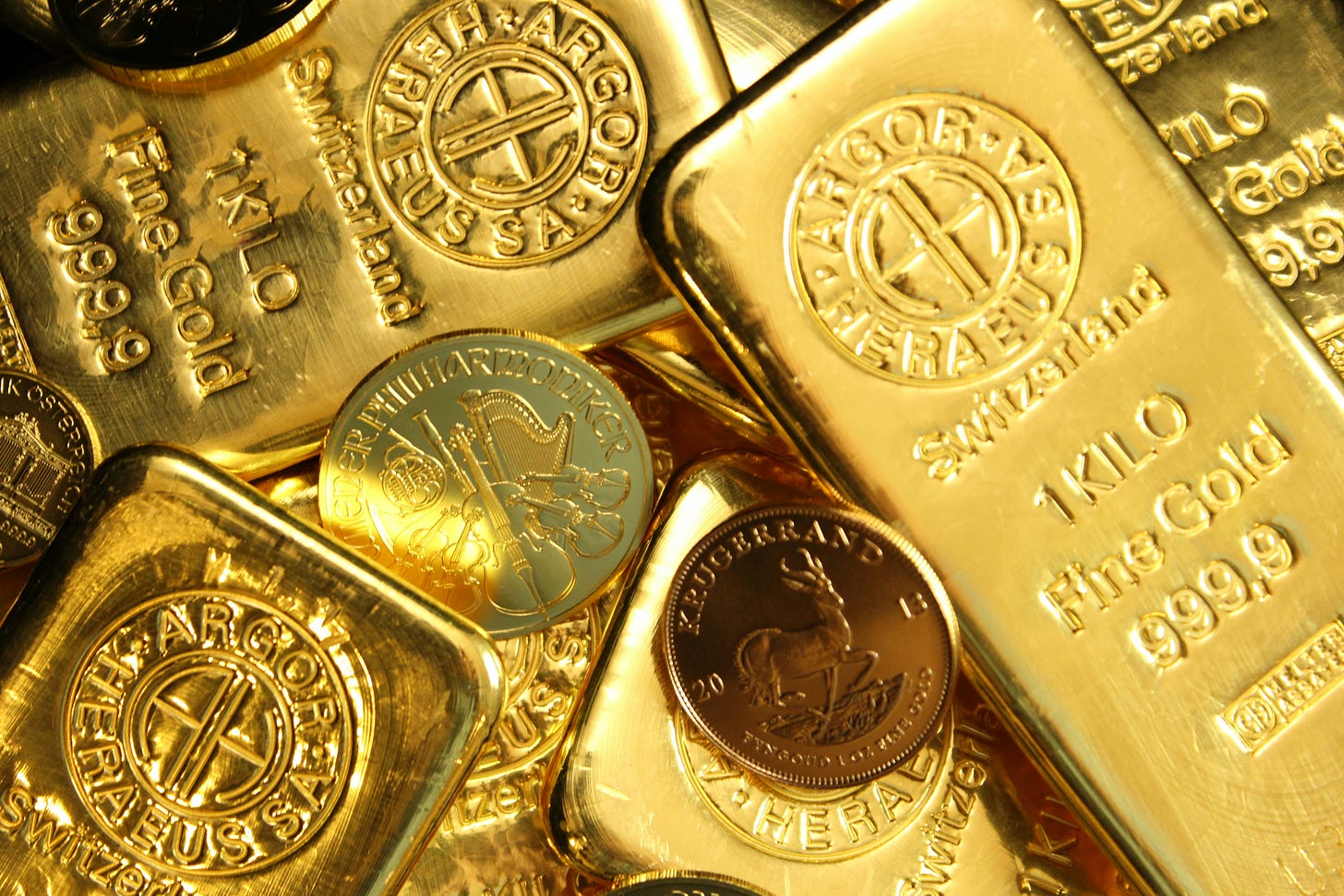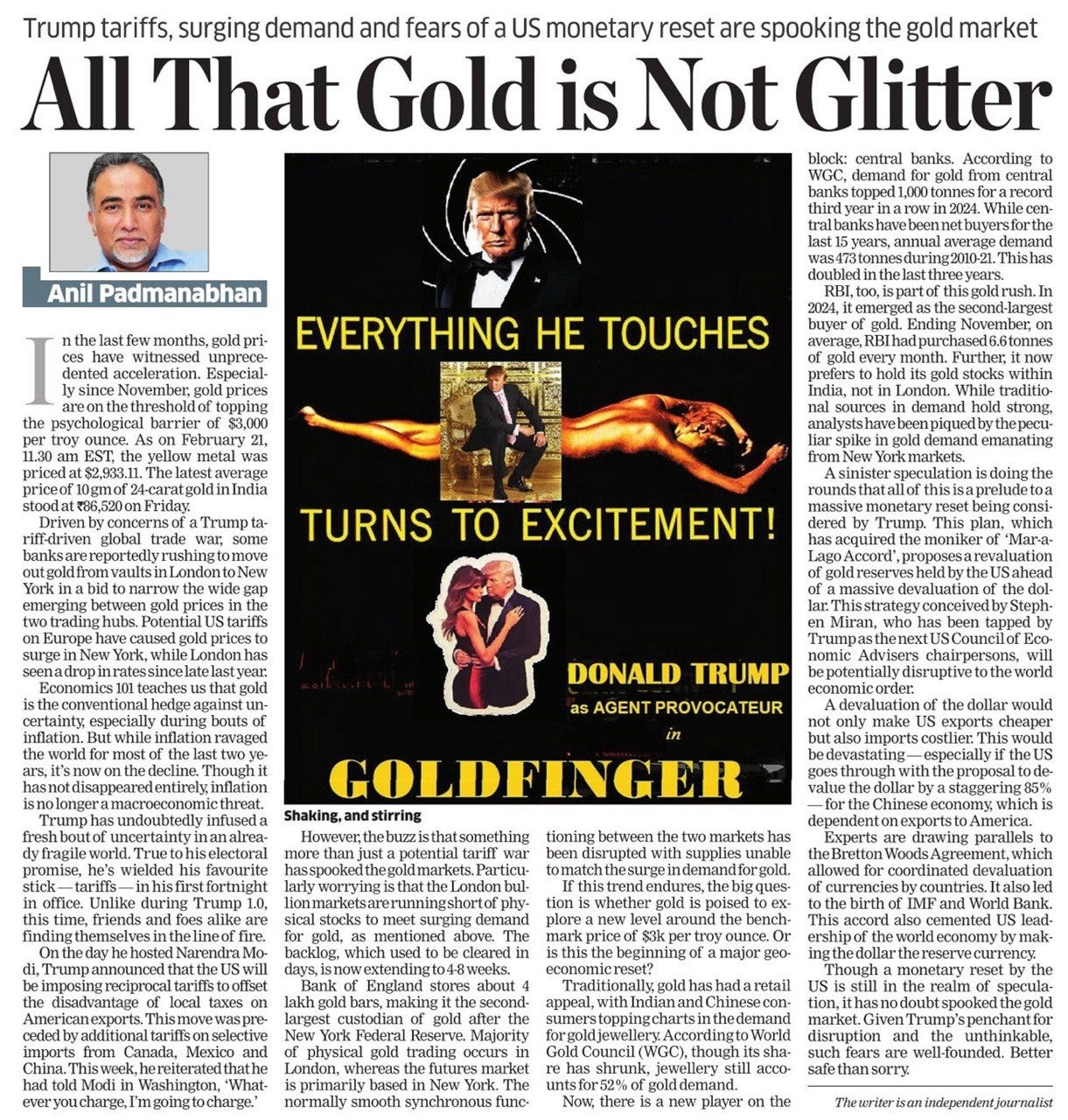The Gold Fever
As the global economy continues to face the headwinds of geopolitics and economic volatility, runaway gold prices are poised to claim a lifetime high. EPISODE #215
Dear Reader,
A very happy Monday to you.
If there is one commodity which has zoomed on the price charts since November, it is gold. In fact, the yellow metal is now poised to top a lifetime high of $3,000 per troy ounce. According to analysts, one of whom featured in my weekly show on StratNewsGlobal.Tech and shared below, gold prices are unlikely to lose these levels in a hurry.
I recall the conversation with a well regarded global gold analyst at the turn of the Millennium, where he argued that gold prices had peaked at around $300 per troy ounce. Needless to say, this claim did not age well.
This week I will unpack the phenomenon of runaway gold prices. Especially what it reveals about the state of geopolitics and the world economy. The cover picture has been taken by Zlaťáky.cz and sourced from Unsplash.
Happy reading.

The Gold High
Beginning November, prices of gold have witnessed an unprecedented acceleration. In fact, the surge is such that prices are poised to achieve a lifetime high of $3,000 per troy ounce—doubling in little under three years.
The thing is that gold has always been considered a hedge against uncertainty. This could be triggered either by inflation, conflicts, epidemics or climate disasters. Now, the global wave of inflation is ebbing. Yes, the world continues to be vulnerable to outbreak of epidemics and periodic episodes of extreme weather—but nothing inclement at present.
This narrows the cause to geopolitics. I would add geoeconomic fragmentation—a fallout of the ongoing geopolitical reset driven by derisking of supply chains—to this mix. The ascendancy of President Donald Trump to the White House has triggered a fresh wave of disruption—especially after he decided to selectively walk-the-electoral-talk on tariffs.
At the same time there is a strong buzz that the United States is considering a radical move around the US dollar—a massive devaluation. Though this is still in the realm of chatter, the unpredictability associated with President Trump means that investors would prefer to be safe (hedge by buying up gold) than sorry.
The Surge
It is apparent from the above chart that gold prices, which have been mostly volatile for the last few years, surged from November 2023. This trend accelerated from September last year.
As on 23 February the price of gold per troy ounce was $2,950.01—higher than the peak shown in the graphic and tantalisingly close to a lifetime high of $3,000.
As pointed out earlier, it is obvious that the gold rush is neither inspired by the threat of inflation—which is on the mend—or an impending pandemic/disaster. Fluid geopolitics, manifesting in geoeconomic fragmentation, is presumably among the primary reasons.
New geopolitical risks triggered by the ongoing decoupling between China and the West—led by the United States—are now creating tremendous uncertainty in the global economy.
Two years ago, the International Monetary Fund (IMF) had warned against this trend at its annual meetings in Marrakech. At that time it said (bold text is my doing):
“Similar to economic integration, the impact of geoeconomic fragmentation can be felt via changing patterns of trade, technology, labor, capital, and the provision of global public goods. These channels interact within and across national borders as well as geographic blocs.
They can operate with greater force during periods of uncertainty, both in terms of the uncertain transition to a more fragmented world, as well as due to lack of clarity about the final shape that a more fragmented world might take.”
I had penned a newsletter developing this theme. Sharing the link below, in case you wish to re-read it.
The Mar-a-Lago Doosra?
Another factor spooking the gold markets is the growing buzz that the United States is considering a massive devaluation of the dollar to simultaneously deal with its debt challenge and trade competitiveness.
I wrote about this in my monthly column in The Economic Times, which was published on Saturday. Sharing the screenshot and link above, and some teasers below.
“The buzz is that something more than just a potential tariff war has spooked the gold markets. Particularly worrying is that the London bullion markets are running short of physical stocks to meet surging demand for gold, as mentioned above. The backlog, which used to be cleared in days, is now extending to 4-8 weeks.
Bank of England stores about 4 lakh gold bars, making it the second largest custodian of gold after the New York Federal Reserve. Majority of physical gold trading occurs in London, whereas the futures market is primarily based in New York. The normally smooth synchronous functioning between the two markets has been disrupted with supplies unable to match the surge in demand for gold.”
And then added:
“A sinister speculation is doing the rounds that all of this is a prelude to a massive monetary reset being considered by Trump. This plan, which has acquired the moniker of ‘Mar-a-Lago Accord’, proposes a revaluation of gold reserves held by the US ahead of a massive devaluation of the dollar.
This strategy conceived by Stephen Miran, who has been tapped by Trump as the next US Council of Economic Advisers chairpersons, will be potentially disruptive to the world economic order.
A devaluation of the dollar would not only make US exports cheaper but also imports costlier. This would be devastating — especially if the US goes through with the proposal to devalue the dollar by a staggering 85% —for the Chinese economy, which is dependent on exports to America.
Experts are drawing parallels to the Bretton Woods Agreement, which allowed for coordinated devaluation of currencies by countries. It also led to the birth of IMF and World Bank. This accord also cemented US leadership of the world economy by making the dollar the reserve currency.”
A reading the tea leaves suggest that gold prices are in for a bumpy ride and are unlikely to recede in the near future. In other words, uncertainty in the global economy is not going away in a hurry. So brace for the worst and pray for the best.
Recommended Viewing
Sharing the latest episode of Capital Calculus. (Please note that Capital Calculus has moved to a new home (stratnewsglobal.tech) within StratNews Global. This relocation will take a bit of getting used to—bear with me.)
Keeping with the theme of this week’s newsletter, I spoke to Renisha Chainani, head of research at Augmont Gold. According to Renisha it is only a matter of time before gold prices soar to a lifetime high of $3,000 per troy ounce.
It may drop thereafter, is likely to maintain this level for some time, especially given the fact that the global headwinds in geopolitics are unlikely to subside in a hurry. Do watch. Sharing the link below.
Do watch.
Till we meet again next week, stay safe.
Thank You!
Finally, a big shoutout to Sanjay, Shiv, Premasundaran, Vijay and Gautam for their informed response, kind appreciation and amplification of last week’s column. Once again, grateful for the conversation initiated by all readers. Gratitude to all those who responded on Twitter (X) and Linkedin.
Unfortunately, Twitter has disabled amplification of Substack links—perils of social media monopolies operating in a walled garden framework. I will be grateful therefore if you could spread the word. Nothing to beat the word of mouth.
Reader participation and amplification is key to growing this newsletter community. And, many thanks to readers who hit the like button😊.




